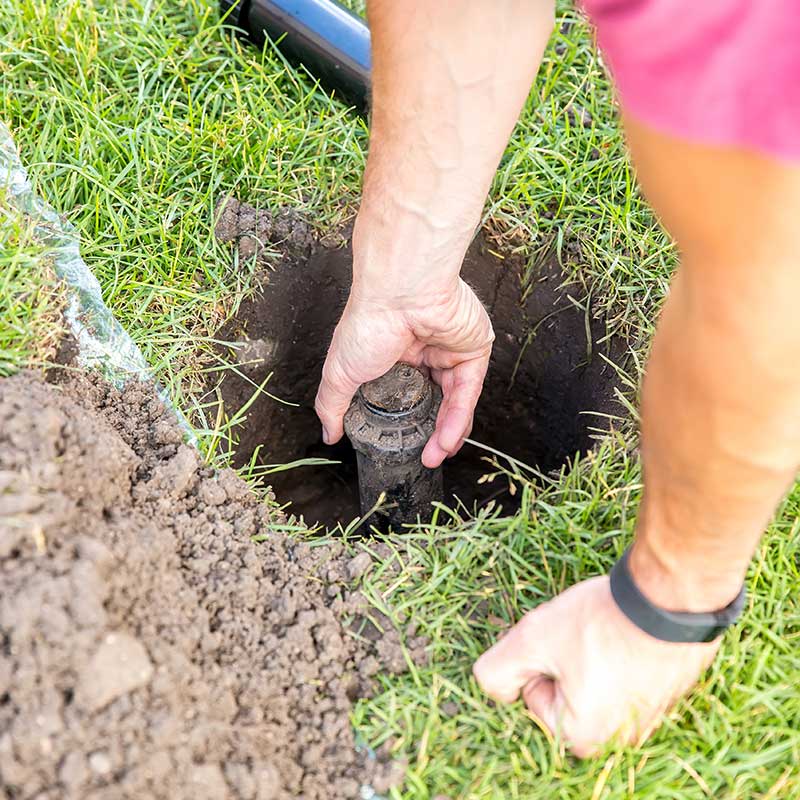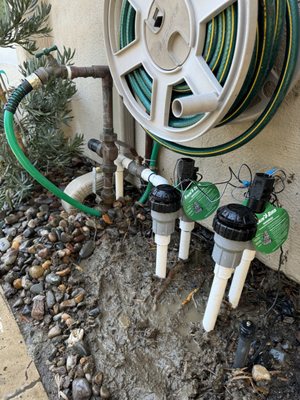Advanced Sprinkler System Repair techniques for consistent irrigation results
Everything About Sprinkler Equipments: Trick Setup Tips and Their Duty in Efficient Watering
Lawn sprinkler systems are essential for efficient watering in various landscapes. They supply targeted hydration and help save water sources. Understanding the different kinds of systems and planning the design is important for reliable setup. Trick installation ideas can make a significant distinction in performance and maintenance. Lots of neglect the details that assure long-term effectiveness. Checking out these facets can disclose vital understandings for anyone taking into consideration a sprinkler system for their garden or grass.
Recognizing Various Sorts Of Lawn Sprinkler Equipments
Automatic sprinkler play a necessary role in preserving healthy and balanced landscapes by making sure sufficient water circulation. Numerous kinds of sprinkler systems deal with various landscape needs and watering timetables. One of the most common types consist of stationary, oscillating, and revolving lawn sprinklers. Fixed sprinklers supply water in a fixed pattern, making them appropriate for little, equally shaped locations. Oscillating lawn sprinklers, known for their side-to-side motion, properly cover larger rectangle-shaped spaces, guaranteeing even water circulation. Rotating lawn sprinklers give targeted insurance coverage by revolving streams of water, ideal for irregularly shaped grass or gardens. On top of that, drip watering systems provide a more reliable choice by providing water straight to the plant's origins, reducing dissipation and drainage. Each kind has distinctive benefits, and comprehending these variants allows home owners to pick the most appropriate system for their particular landscape needs. An appropriate automatic sprinkler can considerably improve water effectiveness and advertise healthier plant development.
Planning Your Automatic Sprinkler Design
Just how does one successfully intend a lawn sprinkler system design to optimize water circulation? Initially, it is essential to evaluate the landscape, keeping in mind the areas that call for watering, such as gardens, lawns, and flower beds. sprinkler system installation. Mapping out these areas aids determine the appropriate sprinkler types and their positionings. The design ought to assure also coverage, preventing completely dry spots and over-saturation
Next, take into consideration the water stress and flow rate available, as these variables influence the choice and positioning of lawn sprinklers. Various lawn sprinkler heads release varying spray patterns and ranges, so picking the best ones for specific areas is necessary. Spacing in between sprinklers ought to adhere to producer guidelines to maintain uniform protection.

Important Tools and Materials for Installation
A successful lawn sprinkler system installment calls for a choice of vital devices and materials to ensure effectiveness and performance. Key tools consist of a shovel for excavating trenches, a level for making certain proper alignment, and a pipeline cutter for accurate cuts. A measuring tape is essential for precise spacing between sprinkler heads. In addition, a Teflon tape can be made use of for securing threaded links, avoiding leaks.
Materials needed for setup incorporate numerous kinds of pipelines, such as PVC or polyethylene, to transport water throughout the system. Sprinkler connectors, heads, and fittings are necessary to finish the setting up. Shutoffs play a critical role in managing water circulation, while a backflow preventer safeguards the supply of water. A controller or timer is important for automating the watering schedule. Together, these products and devices develop the structure for a reliable and reliable lawn sprinkler installment.
Step-by-Step Installation Refine
Before starting the installment of a sprinkler system, cautious planning and preparation are important to guarantee a smooth procedure. The format should be developed, considering the yard's dimensions and plant types to guarantee sufficient insurance coverage. Next, noting the designated sprinkler locations on the ground assists visualize the system.
When the layout is developed, excavating trenches for the pipelines is the next step. The depth and width of the trenches should be sufficient to fit the piping without blocking the surface. After the trenches are prepared, the PVC pipes must be cut to size and attached according to the design.
Mounting the sprinkler heads at the significant areas is important for peak efficiency. Finally, the entire system needs to be connected to the supply of water and examined for leaks. Adjustments can be made to the sprinkler heads for consistent insurance coverage before completing the trenches.

Maintenance Tips for Long-Lasting Performance
To guarantee a lawn sprinkler operates successfully over time, regular upkeep is vital. This consists of carrying out system assessments, changing sprinkler heads for perfect protection, and cleaning filters and nozzles to avoid clogs. By adhering to these practices, property owners can especially extend the life expectancy and efficiency of their watering systems.
Regular System Examinations
While many homeowners concentrate on the initial installation of their automatic sprinkler, normal assessments are important for assuring resilient efficiency. Set up assessments help recognize potential issues, such as leaks, obstructions, or damaged components, which can compromise system effectiveness. Inspecting for appropriate water stress and circulation prices is additionally crucial, as fluctuations can signal underlying issues. Furthermore, checking the control system ensures that sensing units and timers operate precisely, adding to water preservation and lowered utility costs. Homeowners should consider seasonal inspections, especially prior to and after substantial weather changes, to preserve peak performance. By focusing on regular system evaluations, property owners can extend the life-span of their lawn sprinkler and accomplish much more reliable watering throughout their landscapes.
Change Sprinkler Heads
Adjusting sprinkler heads is important for optimizing water circulation and making sure that every location of the landscape gets ample hydration. Correct alignment is crucial; heads must be guided towards the intended locations without overshooting onto walkways or driveways. This change not only preserves water yet also advertises much healthier plant development by supplying moisture go to my site straight to the roots. Routine examination of the sprinkler head's elevation is also important, as yard or plants might obstruct the spray pattern if they expand as well high. In addition, seasonal adjustments may be necessary to accommodate altering climate condition or plant life cycles. By keeping correct changes, homeowners can enhance their automatic sprinkler's effectiveness, resulting in resilient performance and minimized water waste.
Tidy Filters and Nozzles
Normal cleaning of nozzles and filters is vital for preserving the maximum performance of an automatic sprinkler. In time, debris, natural resource, and dust can collect, obstructing water circulation and lowering effectiveness. To ensure effective watering, it is advisable to evaluate filters and nozzles frequently, preferably every few months. When cleansing, customers must get rid of the nozzles and filters, rinsing them completely under running water to displace any fragments. A soft brush can be valuable for stubborn accumulation. After cleansing, it is important to reconstruct the parts appropriately to avoid leakages. This routine maintenance not only boosts the system's capability but likewise prolongs its life expectancy, eventually adding to a much healthier landscape and more efficient water usage.
Ecological Advantages of Sprinkler Systems
Sprinkler systems offer significant ecological benefits, specifically in their effective use of water sources. By delivering water straight to the root zones of plants, these systems reduce evaporation and overflow, making Read Full Report certain that each decrease matters. This targeted method not just conserves water yet also promotes much healthier plant development, decreasing the requirement for chemical plant foods and chemicals that can harm regional ecosystems.
Moreover, several modern-day automatic sprinkler incorporate wise technology, allowing for weather adjustments and moisture picking up. This innovation further boosts water performance, adapting to real-time conditions to stay clear of overwatering. Consequently, these systems contribute to lasting landscape design techniques, aiding to maintain local water tables and reduce the pressure on community water supplies.
Incorporating automatic sprinkler inevitably supports ecological stewardship, fostering an equilibrium in between maintaining green spaces and saving essential all-natural resources. This makes them a beneficial possession for both household and industrial landscapes.
Frequently Asked Concerns
Just how Do I Determine the Right Water Pressure for My System?
To identify the appropriate water pressure for a lawn sprinkler system, one should utilize a stress scale, measure the fixed stress at the faucet, and get in touch with system specifications to ensure optimal efficiency and insurance coverage efficiency.
Can I Set Up a Lawn Sprinkler Myself or Should I Work with a Specialist?
Mounting a lawn sprinkler individually is possible for those with enough understanding and skills. Working with a professional guarantees correct setup, efficient design, and adherence to local regulations, inevitably leading to better system efficiency and long life.
What Prevail Mistakes to Prevent Throughout Installation?
Typical errors during sprinkler installment consist of incorrect spacing of heads, overlooking to adjust water address pressure, overlooking drain concerns, falling short to prepare for future landscape design adjustments, and not examining local laws regarding system setup and water use.
Just How Can I Repair Issues With My Sprinkler System?
To fix automatic sprinkler concerns, one must inspect for obstructions, evaluate shutoffs for appropriate function, assurance sufficient pressure, assess timer settings, and validate that all elements are attached correctly to maintain ideal efficiency. sprinkler repair.
Exist Any Kind Of Regional Regulations for Lawn Sprinkler Installations?
Neighborhood policies for automatic sprinkler installments differ by community. Home owners need to seek advice from neighborhood building ordinance and zoning legislations to ensure conformity, as some locations might have certain requirements relating to water use, system style, and setup techniques.
Sprinkler systems play a necessary role in keeping healthy and balanced landscapes by making sure sufficient water distribution. Various types of lawn sprinkler systems cater to different landscape requirements and sprinkling schedules. Exactly how does one successfully intend a sprinkler system format to optimize water distribution? An effective lawn sprinkler system setup needs a selection of important tools and materials to ensure effectiveness and performance. Lawn sprinkler systems supply significant ecological benefits, especially in their efficient usage of water sources.